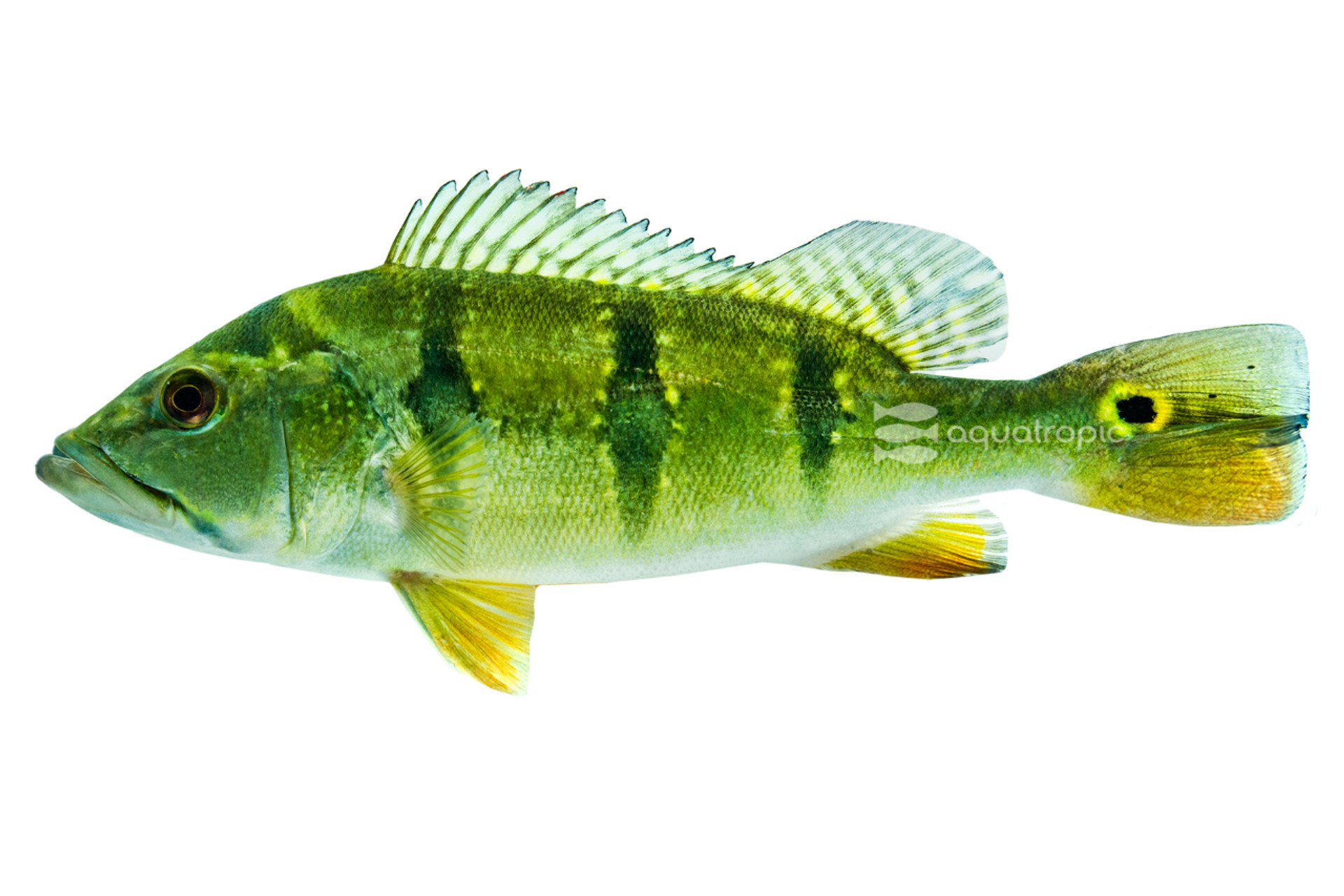A Freshwater Peacock

One of the prettiest fish you'll see for a freshwater aquarium is also one of the fish that spawned the monster fish keeper movement; today, we're talking about Peacock Bass (Cichla ocellaris). In south America, the Cichla family fills a similar niche to the basses of north America. They are popular among sport fishermen for their prodigious appetites and ferocious fight, and they are delicious to boot, with a white flaky meat that people love to cook in a variety of ways. The biggest differences between South American and North American Basses are that the South American ones are often more vibrantly colored, and frequently bigger than their northern counterparts.
Peacock Bass are aptly named, with outrageous coloration that brings a Peacock to mind, mostly because of the prominent spot on their tail that is reminiscent of the spots on the feathers of the bird of the same name. They have bright orange bellies and deep golden bodies, with rich black vertical stripes along their backs. They are a fish you are going to notice, even if they didn't get two feet long (which they can). This size means they are really only appropriate for the biggest aquariums, measured in hundreds of gallons. They also make excellent tropical pond fish for those of you who have outdoor temperatures that can sustain warm water all year round. Whatever you keep them in should have enough space, and some cover like large pieces of driftwood and or large, hardy plants. They are perfect fish for bare bottom displays, which also helps keep the tank clean.
Cichla ocellaris are big eaters, a topic we'll delve into more here shortly. They're also messy. Those big meals mean a lot of waste; not only does their tank need to be big, but the filtration has to be strong as well. They're very adaptable fish that aren't picky in regard to water chemistry as long as your pH and hardness are acceptable for most fish, Peacock Bass won't have a problem there either. These bass can live in temperatures down to the 60's, but will do better, grow faster and be more active in warmer water; anywhere in the 70s is good.
Peacock bass grow quickly up to just over a foot long when their growth slows some, but their appetite doesn't. In the wild, they are ambush hunters and will eat pretty much any fish or invertebrate they can surprise and fit in their large mouths. Keep this in mind when feeding your fish. They're easy to feed and eat a lot. When they're small, they'll love Gamma Bloodworms, Mysis and Brine, but as they grow, they'll need bigger meals, like Gamma Whole Fish. They'll also relish the opportunity to have live meals, like earthworms, red worms, cockroaches, crickets and clean feeder fish if you have a good source for them.
They're also very easy to get on Pellets, and we feed them the Nutramar Freshwater Complete in house. It's packed with protein, and all the vitamins and nutrients they need, though when they get big, it's harder to get them enough pellets. You can also feed them market fish and freshwater prawns from your local fish monger. Nothing like sharing a meal with your pets! When they are small (under six inches) you should feed them once or twice a day, but as they get bigger, they can take larger meals and eat less frequently.
So, let's say you have the right tank (it's really big) and you want to keep this monster. What else to put in this display? You can keep more than one Peacock Bass in a display, but it's best to introduce them at the same time and do so when they are small. They can also be kept with Freshwater Rays, Arowanas, Pacus, Large Cichlids and Catfish. They're a bit territorial, and will definitely eat smaller fish, so keep this in mind when choosing tankmates.
Small specimens of Peacock Bass are regularly available and can be kept in smaller aquariums. You should have a long-term plan for keeping them (or maybe eating them) when they inevitably outgrow most aquariums. Never release your fish into the wild. Hobbyist releases have been blamed for the wild populations that are now well established in the canals of south Florida, where they are a very popular game fish, though some intentional stocking for sport has also happened in private ponds where flooding can also result in their unintentional release.
Are you a monster fish keeper or are you looking to become one? Do you have a few hundred gallons of tank or pond that would look great with a few Peacock Bass in it? These amazing, gorgeous and hardy fish will fill a niche in the right display that few other fish can. If you're ready, head to your local fish store (LFS) and ask them about getting you some Cichla ocellaris from Aquatropic today!